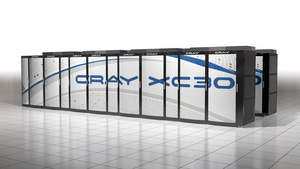Cray Wants Supercomputer Crown With 100 Petaflop XC30

Cray XC30’s Aries interconnects put it ahead of Titan
Cray has launched its XC30 supercomputer codenamed “Cascade”, which looks set to take the crown from which the US Oak Ridge National Laboratory Titan won a few days ago.
Cray says its new machine will scale to 100 Petaflops, while Titan runs at 20 Petaflops.
The Cray XC30 uses Intel processors and accelerators much like the Titan which adds accelerators to AMD processors and achieved more than 20 million billion floating point operations per second (20 Petaflops), but the new supercomputing champion can scale to five times that, and the first orders will soon be shipped to six laboratories around the world.
 Cray: strong persuader?
Cray: strong persuader?
The Cray machine is put together using Intel Xeon ES-2600 chips, and can be fitted with NVidia Tesla GPUs, or in future, the Xeon Phi GPU with which Intel hopes to loosen NVidia’s stranglehold on GPUs for use in giant supercomputers.
Cray’s Intel tie-up is now pretty strong. The supercomputer maker, which originally built its own silicon, now uses Xeons after a previous plan to use AMD processors did not work out.
The new system uses the new “Aries” interconnect chip, which Cray developed, but which has been bought out by Intel, although Cray still has exclusive rights to use the current generations of the product. The machine’s massively parallel processors are connected in a topology called “Dragonfly”, which lets applications run flexibly without being limited to particular local processors.
The XC30 should be comparatively green – it has a new cooling system that uses transverse air flow, and the processors are designed for lower energy use, says Cray.
The first six XC30 machines will go to the Swiss National Supercomputing Centre (CSCS) in Lugano, the Pawsey Centre in Perth, Australia, the Finnish IT Center for Science (CSC), the US Department of Energy’s National Energy Research Scientific Computing Center (NERSC) in Berkeley, Japan’s Academic Center for Computing and Media Studies (ACCMS) at Kyoto Universit, and the University of Stuttgart’s High Performance Computing Center Stuttgart (HLRS) in Germany.
“The Cray XC30 system will be a valuable supercomputing resource for our researchers and scientists, as well as for our industrial partners in the automotive and aerospace industries,” said professor Michael Resch, director of the HLRS laboratory in Stuttgart, the first customer, who signed up for it back in 2010.
“We have worked closely with Cray over the years to ensure our users are equipped with innovative supercomputing systems that are built with leading-edge supercomputing technology, and we look forward to continuing our collaboration with the Cray XC30.”
Do you know about Green IT? Try our quiz!
